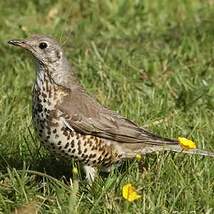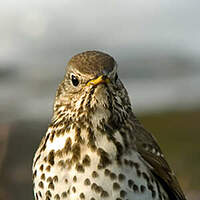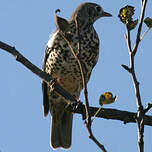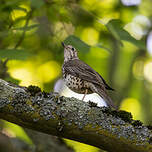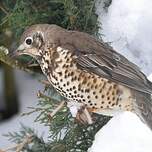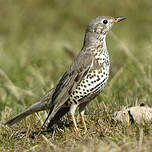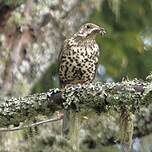Mistle Thrush
Turdus viscivorus - Grive draine
Identification
The Mistle Thrush, a large thrush with a long tail, is the largest of our Turdidae. It can be confused with the smaller Song Thrush in a frontal view and I will point out the differences. Three subspecies are described, which are only slightly different from the nominate. I will describe this latter one which occupies Europe. The Mistle Thrush is recognizable by its large size, its upper parts of a cold brown-grey, the uniformity of which is broken by the light edging of the remiges and coverts, the paleness of the lower parts which show more or less visible dark areas on each side of the chest at the wrists, the head pattern (side of the head showing from front to back a malar streak starting from the beak, a thick vertical stripe under the eye and an arc behind the ear coverts, the three blackish on a whitish background) and the tail showing white in the external rectrices. The eye is dark, the beak strong, blackish, with yellow at the base. Seen from the front, a Song Thrush would show a similar head pattern, but often less noticeable, with a crown of a warm brown and reddish-fawn sides. In addition, the chest and flanks would be more or less tinged with red. The juvenile can be recognized by the mantle and the scapulars streaked with beige-fawn.
Subspecific information 3 subspecies
- Turdus viscivorus viscivorus (Europe to w Siberia and n Iran)
- Turdus viscivorus deichleri (nw Africa, Corsica and Sardinia)
- Turdus viscivorus bonapartei (Sc Asia to Turkmenistan and w Nepal)
Foreign names
- Grive draine,
- Zorzal charlo,
- tordoveia,
- Misteldrossel,
- léprigó,
- Grote Lijster,
- Tordela,
- dubbeltrast,
- Duetrost,
- drozd trskota,
- drozd brávník,
- Misteldrossel,
- kulorastas,
- griva comuna,
- Mistilþröstur,
- paszkot,
- sila strazds,
- carar,
- Деряба,
- ヤドリギツグミ,
- 槲鸫,
- dubbeltrast,
- 槲鶇,
Voice song and call
The song is reminiscent of the Blackbird's but it is poorer, more monotonous, melancholic and above all its tone is much higher. The usual call is a dry and rasping trrrrrt that is very characteristic. The alarm call is of the same type but quickly repeating trrrrrtrrtrrtrrtrrtratratratra.... You can also occasionally hear a rec trec trec... Finally, it can also give a very sharp and hard siii.
Habitat
In western Europe, the Mistle Thrush can be found from sea level up to approximately 1800m in altitude.
Behaviour character trait
Compared to the Musician, the Mistle Thrush is bigger and stands more upright. When alerted, it stretches its neck, its head and its bill slightly raised, and slightly lowers its wings, which reveals its big tail.
It has more of a blackbird's attitude. It is generally a rather solitary bird. However, migrating birds move in small and loose groups, hinting at some gregariousness. Reproduction in small, loose colonies has already been reported, though this doesn't seem to be common. Finally, its liking for mistletoe berries is known, to the point that its winter presence could largely depend on this fruit. It is indeed what gave it its specific Latin name viscivorus, meaning Mistletoe Viscum album eater.Dietfeeding habits
In the spring, the Mistle Thrush is mainly insectivorous. It searches for prey on the ground by making small jumps and using its beak to push away anything that might hide them.
It consumes a lot of insects, especially in the larval stage, Diptera, Coleoptera, Lepidoptera, ... as well as earthworms, small slugs, etc. It uses them to feed its nestlings. In the winter, it becomes more frugivorous/granivorous. It was previously said that it has a liking for mistletoe berries. Many small fruits interest it, the wild strawberries on the ground and many berries from shrubs such as cherry, rowan, elderberry, ivy, etc.Reproduction nesting
The breeding season begins early for the more southern residents, as early as the beginning of March, and extends until July-August for migrants from northern regions.
In western Europe, it runs from late March to June. Two successive clutches are possible. The species is monogamous and territorial. Nesting is arboreal. The nest is built in a fork at a few meters' height in a tree. It is a fairly large nest made of dry twigs, roots, moss and lichen, the interior shaped with mud and lined with fine vegetal elements. The female lays 4 eggs (2-5), slightly bluish or light green, faintly stained with light brown, with some more marked spots, which she incubates for 12-14 days. The young will stay in the nest for another 15 days and then under the adults' care for another 15 days. Unless the female starts a second nest, in which case it is the male who takes care of the young until they are emancipated.Geographic range
Mistle Thrush has a fairly wide distribution in the western Palearctic. From west to east, it breeds from the European Atlantic coast to the centre of Russia and northwest Mongolia. From north to south, it can be found in the boreal forests of Scandinavia and Siberia to the mountains of the Maghreb, Anatolia, Central Asia and the Himalayas. Birds from the north of Europe, Russia, Mongolia and China are migratory due to the cold winter climate. They go south for the winter with resident birds and beyond. For example, in North Africa, Thrush must winter with Spectacled Thrushes in the juniper woods of the lower plateaus compared to the nesting areas.
Threats - protection
IUCN conservation status
concern
in the Wild
threatened
evaluated
The Mistle Thrush is not classified as a threatened species on the IUCN Red List. The thrush still remains a common bird. In some countries, it is likely hunted during the winter season. Current climate changes could have a negative impact on the species' demography.
Sources of information
- IOC World Bird List (v15.1), Gill, F and D Donsker (Eds). 2025-12-07.
- Vol. 10 - Handbook of the Birds of the World, Josep del Hoyo-Andrew Elliott-David Christie
- Les passereaux d'Europe, tome 2, P. Géroudet, M. Cuisin
- Thrushes, Peter Clement and Ren Hathway
- Avibase, Lepage Denis
- Animal Diversity Web, University of Michigan Museum of Zoology
- Birds of the World, The Cornell Lab of Ornithology
- xeno-canto, Sharing bird sounds from around the world,
Other sources of interest
 Specification sheet created on
18/07/2023 by Jean François
Specification sheet created on
18/07/2023 by Jean FrançoisTranslation by AI Oiseaux.net
© 1996-2025 Oiseaux.net
- Accipitriformes
- Aegotheliformes
- Anseriformes
- Apodiformes
- Apterygiformes
- Bucerotiformes
- Caprimulgiformes
- Cariamiformes
- Casuariiformes
- Charadriiformes
- Ciconiiformes
- Coliiformes
- Columbiformes
- Coraciiformes
- Cuculiformes
- Eurypygiformes
- Falconiformes
- Galliformes
- Gaviiformes
- Gruiformes
- Leptosomiformes
- Mesitornithiformes
- Musophagiformes
- Nyctibiiformes
- Opisthocomiformes
- Otidiformes
- Passeriformes
- Pelecaniformes
- Phaethontiformes
- Phoenicopteriformes
- Piciformes
- Podargiformes
- Podicipediformes
- Procellariiformes
- Psittaciformes
- Pterocliformes
- Rheiformes
- Sphenisciformes
- Steatornithiformes
- Strigiformes
- Struthioniformes
- Suliformes
- Tinamiformes
- Trogoniformes





